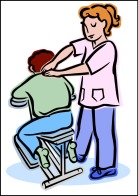Research studies have shown that massage therapy can make a huge difference in the lives of seniors in Assisted Living, Retirement or long term care. They may have li ttle physical contact in an ordinary day, and most live with pain or various chronic ailments. Comfort, calm and ease can be communicated simply with a loving, informed touch.
ttle physical contact in an ordinary day, and most live with pain or various chronic ailments. Comfort, calm and ease can be communicated simply with a loving, informed touch.
Massage has shown to help reduce high blood pressure, recover from surgery or minor injuries, enhance immunity, relieve pain and reduce the need for pain medications, promote relaxation, improve circulation, stimulate bowels, reduce swelling, and relieve muscle tension and stiffness. These are important for people with such varied conditions as diabetes, heart conditions, memory loss, and post-op from hip surgery. It improves both the quality and length of sleep, allowing someone to be more alert and have better daytime social interactions.
 Massage and movement improve joint range of motion, and exercise and stretch muscles. This helps people with arthritis and neurological conditions such as Parkinson’s maintain flexibility and release spasms and cramping, while increasing their motivation for self-care and independence in daily activities.
Massage and movement improve joint range of motion, and exercise and stretch muscles. This helps people with arthritis and neurological conditions such as Parkinson’s maintain flexibility and release spasms and cramping, while increasing their motivation for self-care and independence in daily activities.
Many seniors are concerned with modesty, or have trouble lying flat on a table. Massages can be given on a table with the head or knees elevated, or adapted for a person sitting in a chair or bedbound. They can be done fully clothed, or draped to maintain modesty. Licensed massage therapists are skilled at easing achy backs, and tight shoulders, but will only work where the person wants them to—perhaps the neck, hands and feet, or just the low back.
There are psychological benefits, too. Gentle massage, even to the hands, has been shown to decrease agitation and relieve anxiety in people with dementia or Alzheimer’s, and to improve mood.
Rosi Goldsmith, LMT offers a presentation of interest to activity directors and residents on The Benefits of Massage. She also has designed Body Mapping for Elders to be entertaining and educational. Participants increase internal awareness of movement and sensation, improving safety and ease for sit-to-stand movements and walking. And everyone gets a free shoulder massage!
503-708-2911


